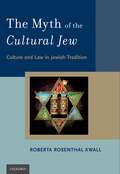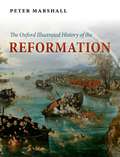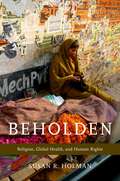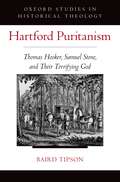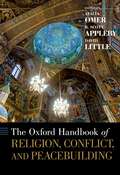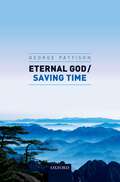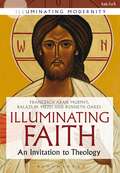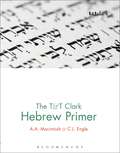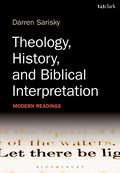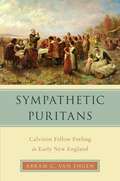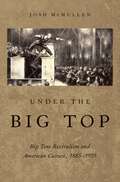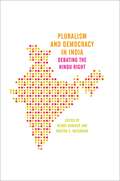- Table View
- List View
Islam in Indonesia: The Contest for Society, Ideas and Values
by Carool KerstenIndonesia's Muslims are still pondering the role of religion in public life. Although the religious violence marring the transition towards democratic reform has ebbed, the Muslim community has polarised into reactionary and progressive camps with increasingly antagonistic views on the place of Islam in society. Debates over the underlying principles of democratisation have further heated up after a fatwa issued by conservative religious scholars condemned secularism, pluralism and liberalism as un-Islamic. With a hesitant government dominated by Indonesia's eternal political elites failing to take a clear stance, supporters of the decision are pursuing their Islamisation agendas with renewed vigour, displaying growing intolerance towards other religions and what they consider deviant Muslim minorities. Extremist and radical exponents of this Islamist bloc receive more international media coverage and scholarly attention than their progressive opponents who are defiantly challenging this reactionary trend. Calling for a true transformation of Indonesian society based on democratic principles and respect for human rights, they insist that this depends on secularisation, religious toleration, and freethinking. Conceived as a contemporary history of ideas, this book aims to tell the story of these open- minded intellectuals and activists in the world's largest Muslim country.
Initiative to Stop the Violence: Sadat's Assassins and the Renunciation of Political Violence (World Thought in Translation)
by al-Gama'ah al-IslamiyahFormerly one of the largest and most militant Islamic organizations in the Middle East, Egypt’s al-Gama‘ah al-Islamiyah is believed to have played an instrumental role in numerous acts of global terrorism, including the assassination of President Anwar Sadat and the 1993 World Trade Center bombing. In later years, however, the organization issued a surprising renunciation of violence, repudiating its former ideology and replacing it with a shari'a-based understanding and assessment of the purpose and proper application of jihad. This key manifesto of modern Islamist thought is now available to an English-speaking audience in an eminently readable translation by noted Islamic scholar Sherman A. Jackson. Unlike other Western and Muslim critiques of violent extremism, this important work emerges from within the movement of Middle Eastern Islamic activism, both challenging and enriching prevailing notions about the role of Islamists in fighting the scourge of extremist politics, blind anti-Westernism and, alas, wayward jihad.
Provincial Hinduism: Religion and Community in Gwalior City
by Daniel GoldProvincial Hinduism explores intersecting religious worlds in an ordinary Indian city that remains close to its traditional roots, while bearing witness to the impact of globalization. Daniel Gold looks at modern religious life in the central Indian city of Gwalior, drawing attention to the often complex religious sensibilities behind ordinary Hindu practice. Gold describes temples of different types, their legendary histories, and the people who patronize them. He also explores the attraction of Sufi shrines for many Gwalior Hindus. Delicate issues of socioreligious identity are highlighted through an examination of neighbors living together in a locality mixed in religion, caste, and class. Pursuing issues of community and identity, Gold turns to Gwalior's Maharashtrians and Sindhis, groups with roots in other parts of the subcontinent that have settled in the city for generations. These groups function as internal diasporas, organizing in different ways and making distinctive contributions to local religious life. The book concludes with a focus on new religious institutions invoking nineteenth-century innovators: three religious service organizations inspired by the great Swami Vivekenanda, and two contemporary guru-centered groups tracing lineages to Radhasoami Maharaj of Agra. Gold offers the first book-length study to analyze religious life in an ordinary, midsized Indian city, and in so doing has created an invaluable resource for scholars of contemporary Indian religion, culture, and society.
Akhenaten and the Origins of Monotheism
by James K. HoffmeierPharaoh Akhenaten, who reigned for seventeen years in the fourteenth century B.C.E, is one of the most intriguing rulers of ancient Egypt. His odd appearance and his preoccupation with worshiping the sun disc Aten have stimulated academic discussion and controversy for more than a century. Despite the numerous books and articles about this enigmatic figure, many questions about Akhenaten and the Atenism religion remain unanswered. In Akhenaten and the Origins of Monotheism, James K. Hoffmeier argues that Akhenaten was not, as is often said, a radical advocating a new religion, but rather a primitivist: that is, one who reaches back to a golden age and emulates it. Akhenaten's inspiration was the Old Kingdom (2650-2400 B.C.E.), when the sun-god Re/Atum ruled as the unrivaled head of the Egyptian pantheon. Hoffmeier finds that Akhenaten was a genuine convert to the worship of Aten, the sole creator God, based on the Pharoah's own testimony of a theophany, a divine encounter that launched his monotheistic religious odyssey. The book also explores the Atenist religion's possible relationship to Israel's religion, offering a close comparison of the hymn to the Aten to Psalm 104, which has been identified by scholars as influenced by the Egyptian hymn. Through a careful reading of key texts, artworks, and archaeological studies, Hoffmeier provides compelling new insights into a religion that predated Moses and Hebrew monotheism, the impact of Atenism on Egyptian religion and politics, and the aftermath of Akhenaten's reign.
Out of Line: A Memoir
by Dov Fedler"You'll be a dentist," says Dad. "Why?" I ask. "Because you'll be called doctor and you won't be called out at night." "I'm not sticking my hands down anyone's mouth. Yech!" DOV FEDLER was a laatlammetjie, born and bred in Johannesburg in 1940 just as Hitler was getting into his stride. A third child was not on his parents' 'want-list'. It was hard enough supporting two much older children and a printing business struggling to exist. When Dov was about three his mother had a 'nervous breakdown' which is when he remembers seeing his first pencil and knowing precisely what it was that he wanted to do with his life. There are no coincidences in Dov's life. He believes that a hand of destiny has steered his path. Many dramatic encounters (not with aliens or spirits, but with everyday people) have shaped him and he wouldn't have missed any of it. Dov's story is intensely personal and honest, with a powerful combination of humour, emotion and community history. OUT OF LINE attempts to do a few short things. It is an autobiography but it is also an attempt to capture a particular history of a specific generation; that of the Jewish baby boomers who descended from mainly Lithuanian stock. Dov has been a leading South African cartoonist for more than 45 years, and his earliest dream was to work for Walt Disney. He has always known his career was somewhere in drawing. He got to visit Disney World and could not wait to leave. He has never been to Europe or Brakpan and is a pure product of Johannesburg. The last on his wish list was to become a political cartoonist.
Stations of the Cross
by Timothy RadcliffeDuring Lent we are surrounded by visual reminders of Jesus' last hours. In Stations of the Cross, renowned author and spiritual master Timothy Radcliffe, OP, offers readers a thoughtful meditation on this powerful devotion. Through word and image Radcliffe offers a profound experience of reflecting on the Stations of the Cross that is both visually and spiritually inspiring. With each reflection, he draws from stunning art commissioned by award-winning liturgical artist Martin Erspamer, OSB.Stations of the Cross is perfect Lenten reading by an author well regarded for his spiritual writings. It is a beautiful invitation to deeper meditation and richer contemplation of this solemn season of prayer and penance.
Family law in contemporary Iran: Women's Rights Activism and Shari'a (International Library of Iranian Studies)
by Marianne BøePassed into law over a decade before the Iranian Revolution, the Family Protection Law drew the ire of the conservative clergy and the Ayatollah Khomeini, and was one of the first laws to be rescinded following the establishment of the Islamic Republic. The law was hardly a surprising target, however, since women's status in Iran was then – and continues now to be – a central concern of Iranian political leaders, media commentators and international observers alike. Taking up the issue of women's status in a modern context, Marianne Bøe offers a nuanced view of how women's rights activists assert their positions within an Islamic context. By weaving together religious and historical texts and narratives with discourses on human rights, these women are able to communicate their views to those in political power. Through her substantial fieldwork and innovative analysis, Bøe undermines both the traditional view of 'Islamic Feminism' as monolithic and instead highlights how women shape the debates surrounding shari'a, women's rights and family law. As such, this book is essential for anyone studying family law and the role of women in contemporary Iran.
The Myth of the Cultural Jew: Culture and Law in Jewish Tradition
by Roberta Rosenthal KwallA myth exists that Jews can embrace the cultural components of Judaism without appreciating the legal aspects of the Jewish tradition. This myth suggests that law and culture are independent of one another. In reality, however, much of Jewish culture has a basis in Jewish law. Similarly, Jewish law produces Jewish culture. A cultural analysis paradigm provides a useful way of understanding the Jewish tradition as the product of both legal precepts and cultural elements. This paradigm sees law and culture as inextricably intertwined and historically specific. This perspective also emphasizes the human element of law's composition and the role of existing power dynamics in shaping Jewish law. In light of this inevitable intersection between culture and law, The Myth of the Cultural Jew: Culture and Law in Jewish Tradition argues that Jewish culture is shallow unless it is grounded in Jewish law. Roberta Rosenthal Kwall develops and applies a cultural analysis paradigm to the Jewish tradition that departs from the understanding of Jewish law solely as the embodiment of Divine command. Her paradigm explains why both law and culture must matter to those interested in forging meaningful Jewish identity and transmitting the tradition.
The Oxford Illustrated History of the Reformation (Oxford Illustrated History)
by Peter MarshallThe Reformation was a seismic event in history, whose consequences are still working themselves out in Europe and across the world. The protests against the marketing of indulgences staged by the German monk Martin Luther in 1517 belonged to a long-standing pattern of calls for internal reform and renewal in the Christian Church. But they rapidly took a radical and unexpected turn, engulfing first Germany and then Europe as a whole in furious arguments about how God's will was to be 'saved'. However, these debates did not remain confined to a narrow sphere of theology. They came to reshape politics and international relations; social, cultural, and artistic developments; relations between the sexes; and the patterns and performances of everyday life. They were also the stimulus for Christianity's transformation into a truly global religion, as agents of the Roman Catholic Church sought to compensate for losses in Europe with new conversions in Asia and the Americas. Covering both Protestant and Catholic reform movements, in Europe and across the wider world, this beautifully illustrated volume tells the story of the Reformation from its immediate, explosive beginnings, through to its profound longer-term consequences and legacy for the modern world. The story is not one of an inevitable triumph of liberty over oppression, enlightenment over ignorance. Rather, it tells how a multitude of rival groups and individuals, with or without the support of political power, strove after visions of 'reform'. And how, in spite of themselves, they laid the foundations for the plural and conflicted world we now inhabit.
Beholden: Religion, Global Health, and Human Rights
by Susan R. HolmanWinner of the 2016 Grawemeyer Award in Religion Global health efforts today are usually shaped by two very different ideological approaches: a human rights-based approach to health and equity-often associated with public health, medicine, or economic development activities; or a religious or humanitarian "aid" approach motivated by personal beliefs about charity, philanthropy, missional dynamics, and humanitarian "mercy." The underlying differences between these two approaches can create tensions and even outright hostility that undermines the best intentions of those involved. In Beholden: Religion, Global Health, and Human Rights, Susan R. Holman--a scholar in both religion and the history of medicine--challenges this traditional polarization by telling stories designed to help shape a new perspective on global health, one that involves a multidisciplinary integration of religion and culture with human rights and social justice. The book's six chapters range broadly, describing pilgrimage texts in the Christian, Hindu, Buddhist, and Islamic traditions; the effect of ministry and public policy on nineteenth-century health care for the poor; the story of the Universal Declaration of Human Rights as it shaped economic, social, and cultural rights; a "religious health assets" approach based in Southern Africa; and the complex dynamics of gift exchange in the modern faith-based focus on charity, community, and the common good. Holman's study serves as an insightful guide for students and practitioners interested in improving and broadening the scope of global health initiatives, with an eye towards having the greatest impact possible.
Hartford Puritanism: Thomas Hooker, Samuel Stone, and Their Terrifying God (Oxford Studies in Historical Theology)
by Baird TipsonStatues of Thomas Hooker and Samuel Stone grace downtown Hartford, Connecticut, but few residents are aware of the distinctive version of Puritanism that these founding ministers of Harford's First Church carried into to the Connecticut wilderness (or indeed that the city takes its name from Stone's English birthplace). Shaped by interpretations of the writings of Saint Augustine largely developed during the ministers' years at Emmanuel College, Cambridge, Hartford's church order diverged in significant ways from its counterpart in the churches of the Massachusetts Bay Colony. Hartford Puritanism argues for a new paradigm of New England Puritanism. Hartford's founding ministers, Baird Tipson shows, both fully embraced - and even harshened - Calvin's double predestination. Tipson explores the contributions of the lesser-known William Perkins, Alexander Richardson, and John Rogers to Thomas Hooker's thought and practice: the art and content of his preaching, as well as his determination to define and impose a distinctive notion of conversion on his hearers. The book draws heavily on Samuel Stone's The Whole Body of Divinity, a comprehensive exposition of his thought and the first systematic theology written in the American colonies. Virtually unknown today, The Whole Body of Divinity not only provides the indispensable intellectual context for the religious development of early Connecticut but also offers a more comprehensive description of the Puritanism of early New England than any other document.
The Oxford Handbook of Religion, Conflict, and Peacebuilding
by Atalia Omer R. Scott Appleby David LittleThis volume provides a comprehensive and interdisciplinary account of the scholarship on religion, conflict, and peacebuilding. Looking far beyond the traditional parameters of the field, the contributors engage deeply with the legacies of colonialism, missionary activism, secularism, orientalism, and liberalism as they relate to the discussion of religion, violence, and nonviolent transformation and resistance. Featuring numerous case studies from various contexts and traditions, the volume is organized thematically into five different parts. It begins with an up-to-date mapping of scholarship on religion and violence, and religion and peace. The second part explores the challenges related to developing secularist theories on peace and nationalism, broadening the discussion of violence to include an analysis of cultural and structural forms. In the third section, the chapters explore controversial topics such as religion and development, religious militancy, and the freedom of religion as a keystone of peacebuilding. The fourth part locates notions of peacebuilding in spiritual practice by focusing on constructive resources within various traditions, the transformative role of rituals, youth and interfaith activism in American university campuses, religion and solidarity activism, scriptural reasoning as a peacebuilding practice, and an extended reflection on the history and legacy of missionary peacebuilding. The volume concludes by looking to the future of peacebuilding scholarship and the possibilities for new growth and progress. Bringing together a diverse array of scholars, this innovative handbook grapples with the tension between theory and practice, cultural theory, and the legacy of the liberal peace paradigm, offering provocative, elastic, and context-specific insights for strategic peacebuilding processes.
Eternal God / Saving Time
by George PattisonStarting from the assumption that 'time is the horizon of the meaning of Being' (Heidegger), Eternal God/ Saving Time attempts to discover what the central religious idea of eternity or of God as 'the Eternal' might mean today. Negotiating ideas of divine timelessness and sempiternity (everlastingness) as well as the attempts of some philosophers to develop the idea of a temporal God, Professor George Pattison surveys a range of positions from analytic philosophy and from the continental tradition from Spinoza through Hegel to the present. Intellectual and cultural forces have tended to separate time and eternity, and both philosophical and theological examples of this tendency are examined. Nevertheless, starting from the experience of life in time, some modern thinkers have developed a new approach to the Eternal as what grounds or gives time. This leads through ideas of novelty, utopia, hope, promise, and call to the projection of a creative and transformative memory-remembering the future-that affirms human solidarity and mutual responsibility. Even if this cannot be made good in terms of knowledge, it offers a basis for hope, prayer, and commitment and these options are explored through a range of Christian, Jewish, Greek, and secular thinkers. This development re-envisages the idea of redemption, away from the Augustinian view that time is what we need to be rescued from and towards the idea that time itself might save us from all that is destructive and tyrannical in time's rule over human life.
The Eucharist: Origins and Contemporary Understandings
by Thomas O'LoughlinTheological reflection upon the Eucharist is dominated by two paradigms: One approach interprets the Eucharist almost exclusively in theological terms, shaped by Scholasticism and the Reformation. Most discussions about the nature of the Eucharist, Eucharistic presence or the role of the priest follow these categories, even if they come in modern disguise. The other reads the Eucharist as an event which can be explored empirically. O'Loughlin develops a new understanding of the Eucharist. This can be done by looking afresh at the historical evidence and bringing it in dialogue with modern theology. In the past decades, historical research and new discoveries have changed our view of the origins and the development of the Eucharist. By bringing history into a fruitful dialogue with sacramental and liturgical theology, he shows not only ways how theology and practice can be brought closer together again, but also how current ecumenical divisions can be overcome. His book makes an important contribution to eucharistic theology, both for individual church traditions as well as for ecumenical dialogues.
Illuminating Faith: An Invitation to Theology (Illuminating Modernity)
by Francesca Aran Murphy Balázs M. Mezei Kenneth OakesThis textbook will give students a clear understanding of the connection between faith and reason. Illuminating Faith gives students a clear and accessible introduction to some of the major ways faith and the relationship between faith and reason have been understood within Western Christianity. In twenty-six short and easy to digest units it covers different accounts of faith beginning with Scripture, moving through the history of Christian thought, and ending with contemporary views. Along the way it explores some of the decisive theological and philosophy accounts of faith, such as faith seeking understanding, faith and supernatural virtue, faith and skepticism, and faith and science. Yet it also includes significant issues and movements not typically covered in introductory texts, such as documents from church councils, faith as knowledge, assent, and trust in the Protestant scholastics, faith and the heart in pietism, secularized accounts of faith, faith after Auschwitz, and faith and liberation. The goal of each unit is to introduce students to topical issues surrounding the nature of faith, to provide historical background for each topic, and to generate further discussion and reflection on the nature of faith. The result is a well balanced and unique introduction to various understandings of faith. Designed specifically with classroom use in mind, Illuminating Faith includes a glossary of words, an update-to-date bibliography, and each chapter ends with questions for discussion as well as suggestions for relevant reading material.
Into the World of the New Testament: Greco-Roman and Jewish Texts and Contexts
by Daniel Lynwood SmithDaniel Lynwood Smith orients readers of the New Testament to its historical and cultural settings, introducing the cast of characters, and illuminating key concepts by exploring their use in ancient texts. Smith includes quotations from many primary sources including Josephus, Tacitus, the Qumran Community, Pliny the Younger, and other carefully chosen texts from lesser-known ancient sources. These texts are all carefully woven together with commentary, to provide a narrative framework for the material and guide students through the text. A glossary of complex terms is provided, to make everything as clear as possible for the newcomer to New Testament studies.This integrative approach both introduces the key sources to the reader and elaborates on their significance for understanding the New Testament. In an admirably concise format Smith is able to cover the military-political history of Israel-Palestine, the messianic movements of Second Temple Judaism, the ancient practice of crucifixion and the development of the Christian canon. Through immersion in these ancient Jewish, Christian, and Greco-Roman texts and contexts, contemporary readers take a step closer to experiencing the New Testament with first-century eyes and ears.
Introducing the New Testament
by Henry WansbroughIntroducing the New Testament presents the complex and often challenging texts and history of the New Testament in a clear and informative manner. The book begins with a section that gives readers a clear idea of how to use it most effectively for study and personal research, followed by a chapter which outlines the various manuscript traditions and processes of transmission that resulted in the biblical texts we have before us today. With this groundwork complete, readers are then introduced to all the texts of the New Testament, and to major issues and debates such as the 'Historical Jesus' the 'Synoptic Problem' and current debates surrounding inspiration - how these texts can be seen in both a historical context and in the context of religious faith. The book features maps, chapter summaries, sample essay questions, chapter bibliographies and reading lists, and an annotated glossary of key terms.
The T&T Clark Hebrew Primer
by A. A. Macintosh C. L. EngleLearning Biblical Hebrew can be extremely difficult. Here at last is a book designed to work in conjunction with the many Hebrew Grammars available in order to break this complex language down into bite-size chunks for revision and consolidation of key aspects of grammar, as well as vocabulary. A.A. Macintosh and C.L. Engle combine insights from teaching Hebrew in both the United States and Europe, and between them bring some fifty years of experience of teaching Hebrew to undergraduate students to this clearly structured book.
Theology, History, and Biblical Interpretation: Modern Readings
by Darren SariskyThe Christian Bible serves as the sacred scripture of the Christian community. It is read regularly by many people around the world today, as it has been for centuries. But how should one interpret this text? This reader presents a variety of perspective on how to relate historical and theological considerations when approaching the Bible. It encourages students and scholars to ponder how historical and theological categories shape one's view of three crucial realities: the text of the Bible, the human subject who reads the text, and the nature of the exchange between the two in the practice of reading. As historical and theological categories are applied to these realities, are they mutually exclusive, or can they be combined in some way? This reader encourages students and scholars to explore these important questions by bringing together a selection of some of modernity's most influential discussions of the issues as well as some of the present day's most distinguished attempts to weigh in on the debate.
Religion of a Different Color: Race and the Mormon Struggle for Whiteness
by W. Paul ReeveMormonism is one of the few homegrown religions in the United States, one that emerged out of the religious fervor of the early nineteenth century. Yet, members of the Church of Jesus Christ of Latter-day Saints have struggled for status and recognition. In this book, W. Paul Reeve explores the ways in which nineteenth century Protestant white America made outsiders out of an inside religious group. Much of what has been written on Mormon otherness centers upon economic, cultural, doctrinal, marital, and political differences that set Mormons apart from mainstream America. Reeve instead looks at how Protestants racialized Mormons, using physical differences in order to define Mormons as non-White to help justify their expulsion from Ohio, Missouri, and Illinois. He analyzes and contextualizes the rhetoric on Mormons as a race with period discussions of the Native American, African American, Oriental, Turk/Islam, and European immigrant races. He also examines how Mormon male, female, and child bodies were characterized in these racialized debates. For instance, while Mormons argued that polygamy was ordained by God, and so created angelic, celestial, and elevated offspring, their opponents suggested that the children were degenerate and deformed. The Protestant white majority was convinced that Mormonism represented a racial-not merely religious-departure from the mainstream and spent considerable effort attempting to deny Mormon whiteness. Being white brought access to political, social, and economic power, all aspects of citizenship in which outsiders sought to limit or prevent Mormon participation. At least a part of those efforts came through persistent attacks on the collective Mormon body, ways in which outsiders suggested that Mormons were physically different, racially more similar to marginalized groups than they were white. Medical doctors went so far as to suggest that Mormon polygamy was spawning a new race. Mormons responded with aspirations toward whiteness. It was a back and forth struggle between what outsiders imagined and what Mormons believed. Mormons ultimately emerged triumphant, but not unscathed. Mormon leaders moved away from universalistic ideals toward segregated priesthood and temples, policies firmly in place by the early twentieth century. So successful were Mormons at claiming whiteness for themselves that by the time Mormon Mitt Romney sought the White House in 2012, he was labeled "the whitest white man to run for office in recent memory." Ending with reflections on ongoing views of the Mormon body, this groundbreaking book brings together literatures on religion, whiteness studies, and nineteenth century racial history with the history of politics and migration.
Aquinas's Way to God: The Proof in De Ente et Essentia
by Gaven KerrGaven Kerr provides the first book-length study of St. Thomas Aquinas's much neglected proof for the existence of God in De Ente et Essentia Chapter 4. He offers a contemporary presentation, interpretation, and defense of this proof, beginning with an account of the metaphysical principles used by Aquinas and then describing how they are employed within the proof to establish the existence of God. Along the way, Kerr engages contemporary authors who have addressed Aquinas's or similar reasoning. The proof developed in the De Ente is, on Kerr's reading, independent of many of the other proofs in Aquinas's corpus and resistant to the traditional classificatory schemes of proofs of God. By applying a historical and hermeneutical awareness of the philosophical issues presented by Aquinas's thought and evaluating such philosophical issues with analytical precision, Kerr is able to move through the proof and evaluate what Aquinas is saying, and whether what he is saying is true. By means of an analysis of one of Aquinas's earliest proofs, Kerr highlights a foundational argument that is present throughout the much more commonly studied Thomistic writings, and brings it to bear within the context of analytical philosophy, showing its relevance to the contemporary reader.
Sympathetic Puritans: Calvinist Fellow Feeling in Early New England (Religion in America)
by Abram Van EngenRevising dominant accounts of Puritanism and challenging the literary history of sentimentalism, Sympathetic Puritans argues that a Calvinist theology of sympathy shaped the politics, religion, rhetoric, and literature of early New England. Scholars have often understood and presented sentimentalism as a direct challenge to stern and stoic Puritan forebears; the standard history traces a cult of sensibility back to moral sense philosophy and the Scottish Enlightenment, not Puritan New England. Abram C. Van Engen has unearthed pervasive evidence of sympathy in a large archive of Puritan sermons, treatises, tracts, poems, journals, histories, and captivity narratives. He demonstrates how two types of sympathy -- the active command to fellow-feel (a duty), as well as the passive sign that could indicate salvation (a discovery) -- permeated Puritan society and came to define the very boundaries of English culture, affecting conceptions of community, relations with Native Americans, and the development of American literature. Van Engen re-examines the Antinomian Controversy, conversion narratives, transatlantic relations, Puritan missions, Mary Rowlandson's captivity narrative -- and Puritan culture more generally -- through the lens of sympathy. Demonstrating and explicating a Calvinist theology of sympathy in seventeenth-century New England, the book reveals the religious history of a concept that has previously been associated with more secular roots.
Under the Big Top: Big Tent Revivalism and American Culture, 1885-1925
by Josh McMullenUnder the Big Top examines the immensely popular big tent revivals of turn-of-the-twentieth-century America and develops a new framework for understanding Protestantism in this transformative period of the nation's history. Contemporary critics of the revivalists often depicted them as anxious and outdated religious opponents of a modern, urban nation. Early historical accounts likewise portrayed tent revivalists as Victorian hold-outs, bent on re-establishing nineteenth-century values and religion in a new America. In this revisionist work, Josh McMullen argues that, contrary to these stereotypes, big tent revivalists actually participated in the shift away from Victorianism and helped in the construction of a new consumer culture in the United States. How did the United States became the most consumer-driven and yet one of the most religious societies in the western world? McMullen shows that revivalists and their audiences reconciled the Protestant ethic of salvation with the emerging consumer ethos by cautiously unlinking Christianity from Victorianism and joining it to the new, emerging consumer culture. Under the Big Top helps to explain the continued appeal of both the therapeutic and the salvific worldview to many Americans as well as the ambivalence that accompanies this combination.
Indian Asceticism: Power, Violence, and Play
by Carl OlsonThroughout the history of Indian religions, the ascetic figure is most closely identified with power. A by-product of the ascetic path, power is displayed in the ability to fly, walk on water or through dense objects, read minds, discern the former lives of others, see into the future, harm others, or simply levitate one's body. These tales give rise to questions about how power and violence are related to the phenomenon of play. Indian Asceticism focuses on the powers exhibited by ascetics of India from ancient to modern time. Carl Olson discusses the erotic, the demonic, the comic, and the miraculous forms of play and their connections to power and violence. He focuses on Hinduism, but evidence is also presented from Buddhism and Jainism, suggesting that the subject matter of this book pervades India's major indigenous religious traditions. The book includes a look at the extent to which findings in cognitive science can add to our understanding of these various powers; Olson argues that violence is built into the practice of the ascetic. Indian Asceticism culminates with an attempt to rethink the nature of power in a way that does justice to the literary evidence from Hindu, Buddhist, and Jain sources.
Pluralism and Democracy in India: Debating the Hindu Right
by Wendy Doniger Martha C. NussbaumWendy Doniger and Martha Nussbaum bring together leading scholars from a wide array of disciplines to address a crucial question: How does the world's most populous democracy survive repeated assaults on its pluralistic values? India's stunning linguistic, cultural, and religious diversity has been supported since Independence by a political structure that emphasizes equal rights for all, and protects liberties of religion and speech. But a decent Constitution does not implement itself, and challenges to these core values repeatedly arise-most recently in the form of the Hindu Right movements of the twenty-first century that threatened to destabilize the nation and upend its core values, in the wake of a notorious pogrom in the state of Gujarat in which approximately 2000 Muslim civilians were killed. Focusing on this time of tension and threat, the essays in this volume consider how a pluralistic democracy managed to survive. They examine the role of political parties and movements, including the women's movement, as well as the role of the arts, the press, the media, and a historical legacy of pluralistic thought and critical argument. Featuring essays from eminent scholars in history, religious studies, political science, economics, women's studies, and media studies, Pluralism and Democracy in India offers an urgently needed case study in democratic survival. As Nehru said of India on the eve of Independence: ''These dreams are for India, but they are also for the world.'' The analysis this volume offers illuminates not only the past and future of one nation, but the prospects of democracy for all.







